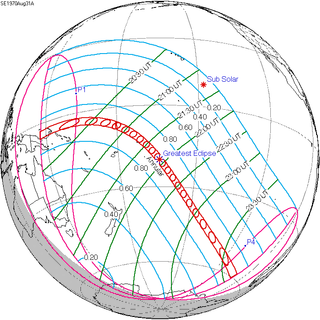| Solar eclipse of August 31, 1970 | |
|---|---|
| Type of eclipse | |
| Nature | Annular |
| Gamma | −0.5364 |
| Magnitude | 0.94 |
| Maximum eclipse | |
| Duration | 407 s (6 min 47 s) |
| Coordinates | 20°18′S 164°00′W / 20.3°S 164°W |
| Max. width of band | 258 km (160 mi) |
| Times (UTC) | |
| Greatest eclipse | 21:55:30 |
| References | |
| Saros | 144 (14 of 70) |
| Catalog # (SE5000) | 9443 |
An annular solar eclipse occurred at the Moon's descending node of orbit between Monday, August 31 and Tuesday, September 1, 1970,[1] with a magnitude of 0.94. A solar eclipse occurs when the Moon passes between Earth and the Sun, thereby totally or partly obscuring the image of the Sun for a viewer on Earth. An annular solar eclipse occurs when the Moon's apparent diameter is smaller than the Sun's, blocking most of the Sun's light and causing the Sun to look like an annulus (ring). An annular eclipse appears as a partial eclipse over a region of the Earth thousands of kilometres wide. Occurring only about 20 hours after apogee (on August 31, 1970, at 2:00 UTC), the Moon's apparent diameter was smaller.[2]
Annularity was visible from the Territory of Papua and New Guinea (today's Papua New Guinea), Gilbert and Ellice Islands (the part that belongs to Tuvalu now) on September 1 (Tuesday), West Samoa (name changed to Samoa later) and the whole American Samoa except Swains Island on August 31 (Monday). A partial eclipse was visible for parts of Eastern Australia, Oceania, and Antarctica.
- ^ "August 31–September 1, 1970 Annular Solar Eclipse". timeanddate. Retrieved 8 August 2024.
- ^ "Moon Distances for London, United Kingdom, England". timeanddate. Retrieved 8 August 2024.
